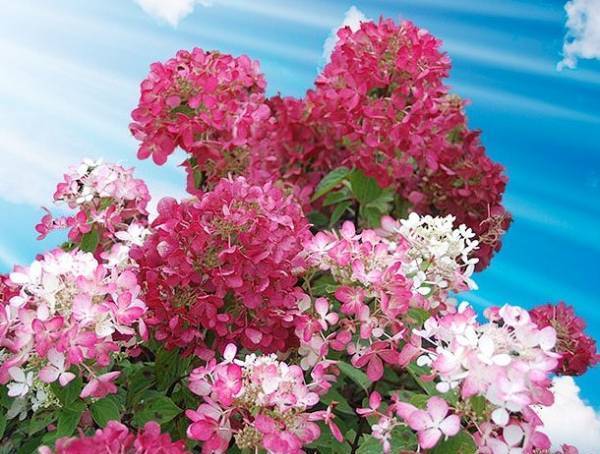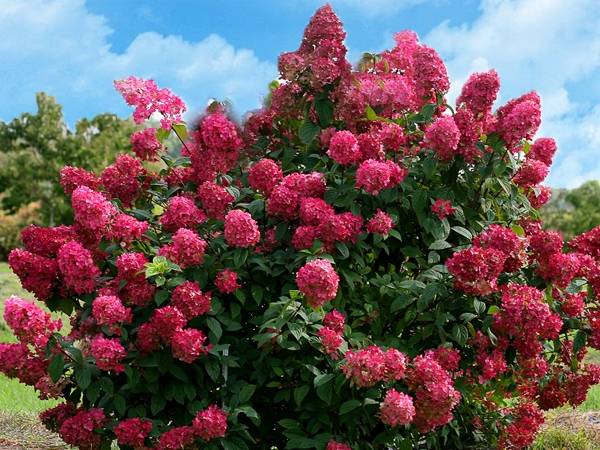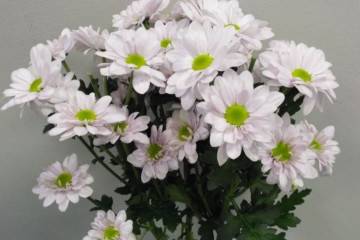Hydrangea Diamond Rouge: how to grow outdoors, features of the variety
Content:
The French nursery, engaged in selection, has brought out a new variety of panicle hydrangea Diamond Rouge. He immediately received various awards, because he has a number of distinctive qualities that distinguish him favorably from other varieties of culture. More details about this wonderful Diamond hydrangea will be discussed later.
Description of hydrangea Diamant Rouge
Hydrangea Diamond Rouge grows as a shrub, suitable for growing in gardens and parks. It is distinguished by its beautiful appearance. It can reach a height of one and a half meters, and in diameter - 1.4 m.
The buds are large in size, gather in the form of panicles. The length of the inflorescences can reach 30-40 cm. The variety begins to bloom in the second or third decade of June, it all depends on temperature indicators. Hydrangea Diamant Rouge first blooms with white panicles, then the buds turn pink, and only by autumn they acquire a red hue.
The leaves have an elongated oblong shape, they also change color from green to orange. This property makes the shrub even more unique.
After planting, the Diamant hydrangea will bloom for the first time in 3 years.
The bushes are distinguished by their winter hardiness, and caring for them is not difficult at all.
Planting hydrangeas outdoors
From the correct choice of place and method of planting in open ground, it depends on what kind of hydrangea will grow and whether it can take root on the site. Therefore, great attention is paid to these aspects.
Illumination
The shrub loves light, but you should not choose a place where direct sunlight will fall on it, the flowers become smaller in the sun. It is better to allocate a place for planting in partial shade. Hydrangea does not like dry soil, so it is important to ensure good watering for it.
The soil
Hydrangea Paniculata Rouge thrives in loamy and clayey fertile moderately moist loose soil containing organic matter. The best environment for hydrangea Diamant is acidic or neutral. The soil can be prepared by adding milk whey, because the sandy soil is not for this crop. To create an acidic environment, brown peat, sawdust and rotted needles are added to the soil.
When to plant
Bushes can be planted in early spring or autumn.
Breeding varieties
Propagation of hydrangea Diamond Rouge is possible by seeds, cuttings and layering.
The first method gives too little chance of getting healthy bushes and takes a very long period of time (from 4 years).
The second option is more efficient. For cuttings, this year's shoots are used in June, last year's will take root worse. A shoot with three or more eyes is cut off, it is necessary that 2 cm remain from the bottom, the leaves are removed from above. The cuttings are placed in water for several days, adding a growth stimulant to it.
The next stage is placing the cuttings in a container with soil of peat and sand in a 2: 1 ratio. It is deepened by 2/3, sand is poured on top. Cuttings are covered with glass or foil, watering is carried out every day. After 21 days, the first roots will appear. The containers can be removed without stopping watering. In winter, it is worth moving them to a cool place, but without freezing temperatures.They are transplanted to a permanent place a year later in August.
For reproduction by layering, they dig a groove next to the main bush, bend down the lower shoots, on which it is necessary to make several cuts, fix them with something heavy to the ground. The groove from above is covered with soil and watered. By next spring, new shoots can be expected, but their transplantation is possible only after a year.
Care rules
Only with proper care will Hydrangea Paniculata Diamond Rouge delight you with its gorgeous flowering.
How and how much to water
This shrub is watered often and abundantly, this is perhaps the only drawback of the variety. In hot weather, it is moistened at least twice a week. To avoid cracking the soil, it is loosened. You can also mulch with needles and peat.
Top dressing and fertilization
For the first feeding, a diluted nettle infusion is suitable. Every 10 days, mineral fertilizers are applied, which are added to the water for irrigation. Chicken droppings and manure are suitable as organics. The treatment is carried out with iron chelate, fertilizers are added every 2 weeks. Without this, the shrub will rarely bloom, and the flowers will be faded.
Pruning panicle hydrangea
Pruning should be done once a year. Cut off the bushes in the fall, removing all old inflorescences and weak branches. Only 12 of the strongest shoots should be left. In the spring, the hydrangea is pruned before bud break. Shoots are shortened to a young plant up to 3 buds, to an adult up to 5. This helps to strengthen the crown and obtain large inflorescences in summer. In parallel with pruning at this time, it is recommended to carry out top dressing.
Possible variety problems
Like other plants, the Diamant Rouge hydrangea can be susceptible to various diseases. Description of possible ailments:
- white rot. The root system falls under the defeat, the flowers do not receive nourishment and, as a result, dry up;
- gray rot. It is manifested by fungal formations of brown color, it is necessary to start treatment immediately;
- powdery mildew. Leaves are affected, as a result, the stems and inflorescences die off;
- tracheomycotic wilting. A type of fungal disease that gradually affects the entire plant as a whole.
To combat these diseases, fungicidal agents are used.
Also, the hydrangea can be attacked by parasites: aphids, bugs, weevils, etc. They are fought with insecticidal preparations.
Winter hardiness of hydrangea Diamant Rouge
Young bushes can grow in the frost resistance zone 5a, therefore, they should be covered for the winter for the first 3 years. Mature plants no longer need shelter in winter.
It is not for nothing that this variety has the word diamond in its name, because it looks gorgeous and can decorate any park or garden. Its frost resistance makes Diamand Rouge attractive for planting in cold areas. Care is required simple, as a result an attractive shrub with bright buds will grow.



















